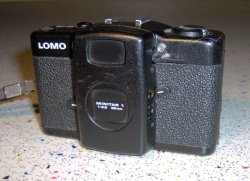The Third Lomographic Happening

Soviet-era LOMO LC-A portable camera. Source: Wikimedia Commons.
“Moscow in New York: The Third Lomographic Happening” sounded like it was going to be a hot ticket, and that’s why I went. I mean, partly it’s just that noun, “Lomographic,” one of those words that seems to have come into being just so you can sound hip when you use it. Plus, the show was not just work by a bunch of people who use Lomography; it was put on by the Lomographic Society. What could be more seductive? Can you think of anything you’d like more than to be able to say, offhand: “Hey, I’m a member of the Lomographic Society, so don’t try anything.” Or: “I can’t make a plan for Thursday ’cause I’ve got another meeting of the Lomographic Society. You wouldn’t be welcome.” People in New York pay through the ears for access to this kind of line. They get references, buy special clothes, select the right health clubs. Now all you need is a bad camera (cock that shutter) and you’re set.
But the hipness doesn’t stop there. The Lomographic Society is a Moscow-and-Vienna-based operation (’tis the season for Mitteleuropa), so it hails from the capitals of two countries that at different points in history have been big enemies of the U.S. and now they’re rolled into one project. We’re a Prozac nation so far past our depressive days that our old enemies are all we can love. Cool. The materials you need to get in on the act are cheap: a Lomo is a Russian Instamatic camera of dubious quality that takes marginally distorted photos. It looks fab when you carry it around: like so much stuff from Russia, it’s not retro, but is, rather, the totally authentic product of a society in which industrial design stalled under Stalin. When normal Russians in Russia take photos with a Lomo, they’re local tourists, but if you know about the cult, you can take a picture with a Lomo, laugh about the distortions, celebrate the distortions, pretend that the distortions are really interesting, and call yourself a lomographer.
So just a word about the Lomography show, in case you wondered: some of these people are really good photographers, and therefore some of them take really good pictures. Since most of the folks mounting the exhibition were Austrian, both the photos and the means of displaying them were marginally sadistic (an esthetic, not a practice), and very slick and clean. The contrast between that Austrian we-make-the-best-technology- in-the-world attitude and that Russian we-can’t-make-a-toilet-that-flushes attitude really had very little to do with what the pictures looked like, but it definitely lets you in on what Lomography is and why the show was, in its way, kinda fun. Lomography is not an art form; it’s a way of being.
In my undergraduate days, I worked on my college literary magazine, and whenever we had a weird blank column that we had not anticipated, we filled it in with what we used to call the “Matisse-y graphics,” which were little shreds of black paper glued in random quasi-floral arrangements. It was a four A.M. kind of thing. It hardly mattered what shape the black scraps were, because the effect always seemed to us to be really pretty amazingly cool. Crying shame that none of us had a Lomo: photos would have been only slightly more expensive to screen, and “Lomography” sounds about a million times better than “Matisse-y graphics.”











